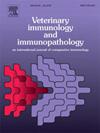In situ staining with antibodies cross-reactive in pigs, cattle, and white-tailed deer facilitates understanding of biological tissue status and immunopathology
IF 1.4
3区 农林科学
Q4 IMMUNOLOGY
引用次数: 0
Abstract
Identifying cellular markers within archived formalin-fixed, paraffin-embedded (FFPE) tissues is critical for understanding tissue landscapes impacting animal health, but in situ detection methods are limited in veterinary species by a restricted toolbox of species-compatible immunoreagents. We identify antibodies with conserved in situ reactivity to IBA-1 (macrophages/dendritic cells), CD3ε (T cells), Pax5 (B cells), Ki-67 (cycling cells), and cytokeratin type I/II (epithelial cells) in FFPE tissues of pigs, cattle, and white-tailed deer. Multiplexed brightfield detection (IBA-1/CD3ε/Pax5) in lymph nodes of all three species demonstrated species-specific and species-conserved features of cellular architecture. Multiplexed fluorescent staining in pig lymph nodes for IBA-1/CD3ε/Pax5/Ki-67 allowed detection of colocalizing signals and identification of active germinal centers. Antibody compatibility with RNA in situ hybridization was confirmed for all antibodies in all species, allowing co-detection of RNA markers, which is a strategy highly useful in veterinary species where protein-reactive reagents are often lacking. Multiplexed protein and RNA staining was performed in tonsil tissue of a pig infected with Senecavirus A, enabling identification of virally-infected cell types via simultaneous detection of host cell type-specific proteins and virus-specific RNA. Findings have important applications for future in situ identification and comparative study of tissue landscapes and immunopathology in a diverse range of veterinary species.
在猪、牛和白尾鹿中使用抗体交叉反应原位染色有助于了解生物组织状态和免疫病理。
鉴定存档的福尔马林固定石蜡包埋(FFPE)组织中的细胞标记物对于了解影响动物健康的组织景观至关重要,但原位检测方法在兽医物种中受到物种相容免疫试剂有限工具箱的限制。我们在猪、牛和白尾鹿的FFPE组织中鉴定出对IBA-1(巨噬细胞/树突状细胞)、CD3ε (T细胞)、Pax5 (B细胞)、Ki-67(循环细胞)和细胞角蛋白I/II型(上皮细胞)具有保守原位反应性的抗体。这三种物种淋巴结的多路明场检测(IBA-1/CD3ε/Pax5)显示了细胞结构的物种特异性和物种保守性特征。猪淋巴结IBA-1/CD3ε/Pax5/Ki-67的多重荧光染色可以检测共定位信号并识别活跃的生发中心。在所有物种的所有抗体中,抗体与RNA原位杂交的相容性被证实,允许RNA标记的共同检测,这是一种非常有用的策略,在缺乏蛋白质反应试剂的兽医物种中非常有用。在感染塞内卡病毒a的猪扁桃体组织中进行多重蛋白和RNA染色,通过同时检测宿主细胞类型特异性蛋白和病毒特异性RNA来鉴定病毒感染的细胞类型。研究结果对未来不同兽医物种的原位鉴定和组织景观和免疫病理学的比较研究具有重要的应用价值。
本文章由计算机程序翻译,如有差异,请以英文原文为准。
求助全文
约1分钟内获得全文
求助全文
来源期刊
CiteScore
3.40
自引率
5.60%
发文量
79
审稿时长
70 days
期刊介绍:
The journal reports basic, comparative and clinical immunology as they pertain to the animal species designated here: livestock, poultry, and fish species that are major food animals and companion animals such as cats, dogs, horses and camels, and wildlife species that act as reservoirs for food, companion or human infectious diseases, or as models for human disease.
Rodent models of infectious diseases that are of importance in the animal species indicated above,when the disease requires a level of containment that is not readily available for larger animal experimentation (ABSL3), will be considered. Papers on rabbits, lizards, guinea pigs, badgers, armadillos, elephants, antelope, and buffalo will be reviewed if the research advances our fundamental understanding of immunology, or if they act as a reservoir of infectious disease for the primary animal species designated above, or for humans. Manuscripts employing other species will be reviewed if justified as fitting into the categories above.
The following topics are appropriate: biology of cells and mechanisms of the immune system, immunochemistry, immunodeficiencies, immunodiagnosis, immunogenetics, immunopathology, immunology of infectious disease and tumors, immunoprophylaxis including vaccine development and delivery, immunological aspects of pregnancy including passive immunity, autoimmuity, neuroimmunology, and transplanatation immunology. Manuscripts that describe new genes and development of tools such as monoclonal antibodies are also of interest when part of a larger biological study. Studies employing extracts or constituents (plant extracts, feed additives or microbiome) must be sufficiently defined to be reproduced in other laboratories and also provide evidence for possible mechanisms and not simply show an effect on the immune system.

 求助内容:
求助内容: 应助结果提醒方式:
应助结果提醒方式:


